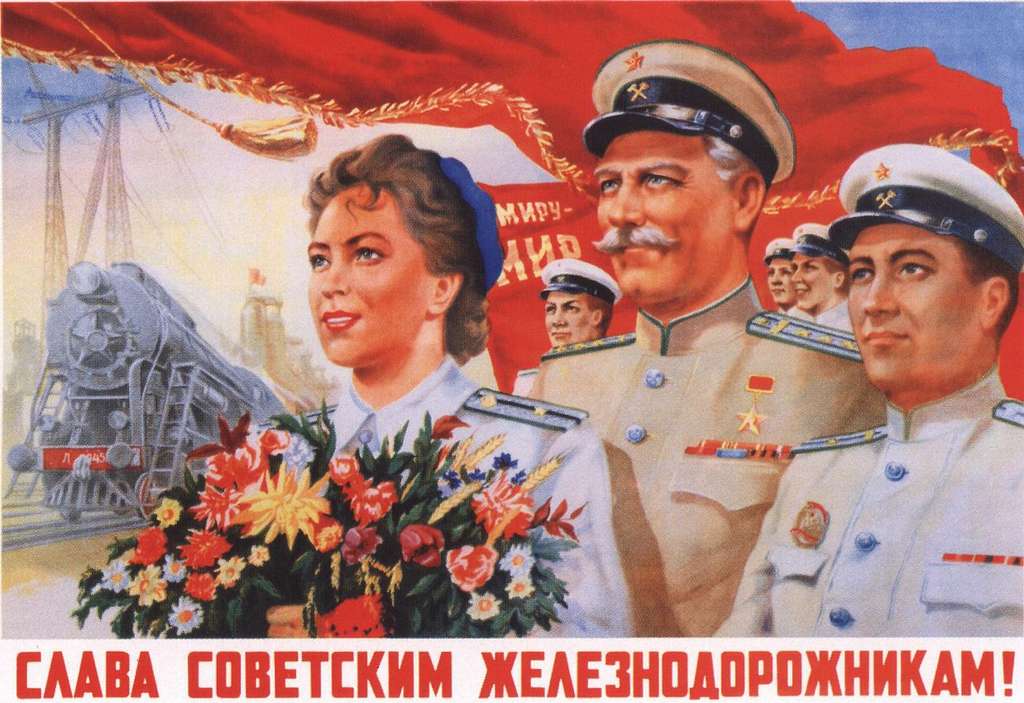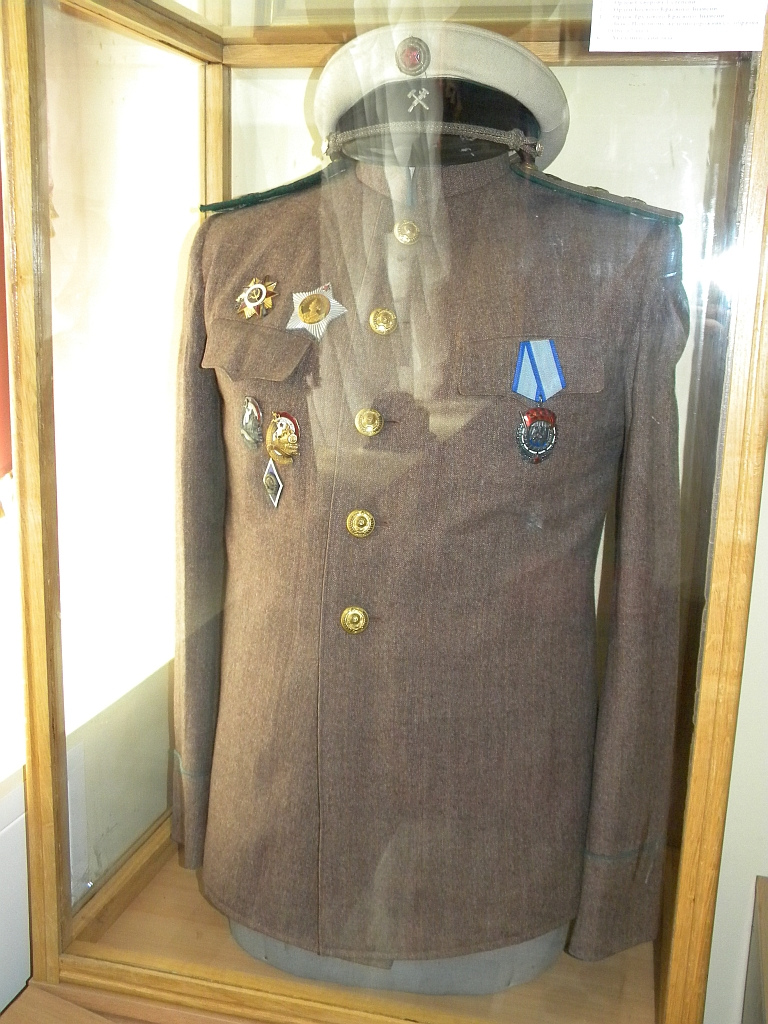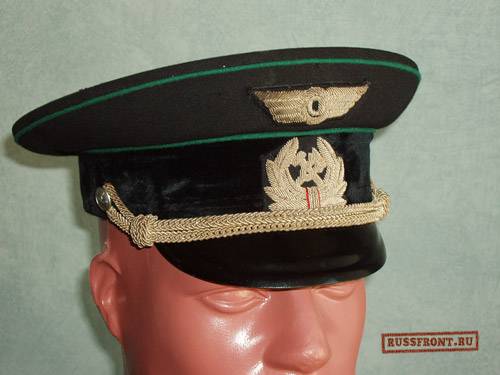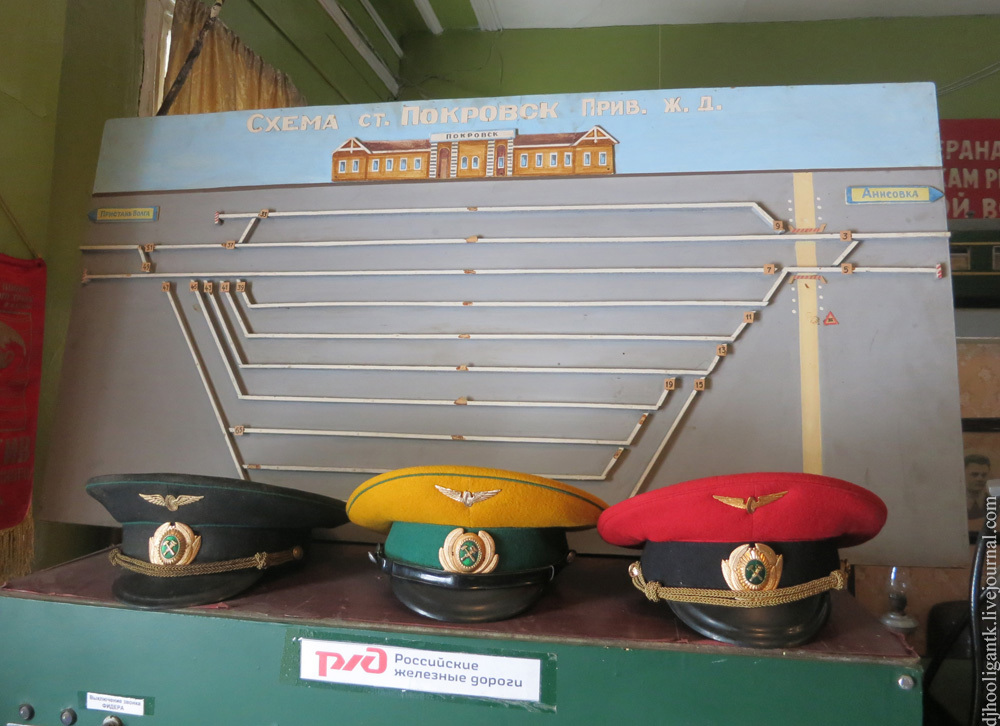 Caps of the Soviet Railways
Caps of the Soviet RailwaysShown here are caps worn by workers and supervisors of the Soviet Railways. Railroads have always been vital to the functioning of the Soviet State - both militarily and economically. As such, Soviet railroad personnel typically received recognition and respect in excess of their counterparts elsewhere in the world. Once under the Commissariat/Ministry of Communications, the later independent Soviet Ministry of Railways was responsible for the largest railway system in the world; incorporating at its peak 31 separate regional railroads under its umbrella. Cross country and metropolitan (metro) lines were its responsibility - but not streetcars, which fell under the Ministry of Housing & Public Utilities.
Of all the Non-MOD visor caps, Railroad caps are the most often seen and collected - at least the later ones. Railway uniforms have also been the best documented outside the Ministry of Defense, with virtually every regulated uniform change since 1943 available on Russian websites or collector forums. I have also been fortunate in amassing a very comprehensive collection of these caps - which I believe well displays their evolution over the Cold War period.
1943 was a seminal year in the development of railroad uniforms. In that wartime year, as the military was undertaking a major uniform change itself, Railways uniforms were "militarized", incorporating many of the same elements used in the Red Army. The standard uniform was dark blue (although black material was also sometimes used), with light brown (khaki) and white tunic variants for summer/hot wear. These latter colors were, in practice, generally confined to high-ranking personnel and were rarely seen. Shoulderboards denoting rank were also authorized, although these were relatively short-lived, being replaced with sleeve insignia postwar. Uniform caps were also made from dark blue/black cotton or wool cloth with a black wool or velvet band, piped with green wool. A khaki-topped version matching the khaki tunic and a white cover for the dark blue cap for wear with the white tunic also existed. These uniforms remained in use until 1955, when, following the death of Stalin, the military look was toned down and certain pre-war uniform elements - like departmental colored piping - were reintroduced. Dark blue uniforms (again often nearly black) uniforms remained standard for winter wear and for junior personnel. Uniforms were greatly simplified in 1963 when piping colors were unified back to green and winter uniforms officially became black. Less-comprehensive uniform "tweaks" occurred in 1973 and 1979, affecting insignia worn on tunics and caps. The last major change occurred in 1985, when dark blue replaced the black winter uniform tunics and cap tops - changes that remained in place through the end of the USSR. Throughout this entire period specialized caps for station commandants and signalers also existed - examples of which are shown below.
A thumbnail image accompanies each cap description. Clicking on that thumbnail will bring up a larger, higher resolution image.
Worker/Supervisor
1932-1943
While I believe this cap was actually made (or at least renovated) for a Soviet film studio, I am including it to illustrate the cap cockade worn by Railways personnel from 1932 until new insignia was introduced in
1943. This took the shape of a beautiful brass and red enamel star with an embossed symbol showing an on-coming train locomotive driving down a length of track. A number of versions exist of this symbol, varying
especially in the size of the locomotive. Be aware there are very nice reproductions of this star being sold - which are discernable by either being made of aluminum or having cold enamel (paint), which can
be seen under a black light. The buttons on an original cap from this period would also have buttons stamped with this same on-coming train symbol, as also seen here.
If Original - Very Rare
Railways
Senior/Middle Staff Winter
1943-1955
This cap was part of the winter dark blue uniform introduced in 1943 for all personnel. While issue junior personnel uniforms were usually blue-black in shade, those tailor-made for more senior Railway officials were usually in a truer dark blue hue, such as on the napped wool crown of the cap shown here. The band is black velvet - which was only authorized for middle, senior and highest staff; caps made for junior staff and rank and file had a plain black cloth (wool) band. Green piping was standard for all personnel over this period. The cap's structure is typical of 1940s manufacture: the crown is low and small in circumference while the black fiberboard visor is spade-shaped. All Railways' caps other than the highest staff mounted a black oilcloth chinstrap. This strap was held in place by two silver-colored metal buttons embossed with the now-standard Railways' emblem: a crossed wrench and hammer. The most distinctive feature of 1943-1955 caps was the use of a small Red Army-type red star (brass-coated steel with hot red enamel) pinned through the crown. A silver crossed wrench and hammer emblem was pinned through the band.
Red and yellow-topped versions of these caps also existed, later versions of which are described below.
Rare
Railways (Operations)
Junior Staff/Worker Winter
1955-1963
Railway uniforms underwent significant changes in 1955 with the re-introduction of department-specific piping and loss of the crown red star;
significantly altering the appearance of their associated visor caps. The cap shown here was worn by junior personnel assigned to operational departments (movements, passenger service, and
communications) - as evidenced by the crimson-colored piping around the crown and band. Both crown and band are dark blue-black napped wool (a hue referred to as
"invisible"). The black painted fiberboard visor is semi-circular in shape, reflecting changes being made to Soviet Army visors at the beginning of this same period. The oilcloth chinstrap is
secured by two nickel-plated Railways' buttons. Insignia is now limited to a nickel-plated brass crossed wrench and hammer cockade (heavily worn in this case) pinned through the band.
Although officially a "winter" cap, most junior personnel wore these dark blue/black caps all year round. Only more senior personnel could afford the light brown or white summer versions.
Rare
Railways (Traction)
Senior/Middle Staff Winter
1955-1963
The blue piping on this cap identifies the wearer as working in the locomotive or rolling stock (traction) departments of the Railways. The crown is sewn from a heavy dark blue/black wool blend (not the napped wool on the previous cap) - now faded by the sun. The band is black velvet, which by regulation was only authorized to middle/senior/highest command staff personnel. The visor is black fiberboard in the older squared-off spade shape. Finding such a visor on a factory-made cap during this period most likely reflects the factory using up obsolete stocks. A black oilcloth chinstrap, nickel-plated buttons and a nickel-plated Railways cockade finish up the ornamental elements of the cap.
Alternatively, this cap may have been worn by a student of a Vocational School during the 1940s. Such students wore the same cap and insignia. Without a date, it is impossible
to differentiate the two cap groups; although the presence of the spade shaped visor, which was rarely used after 1955, leads some weight to concluding a Vocational School origin.
Consequently, this same cap is discussed as on my
Students page.
Rare
Railways (Tracks, Buildings, Main Staff)
Senior/Middle Staff Winter
1955-1963
This cap displays the last of the three piping colors used during the 1955-1963 period; in this case green for personnel assigned to track and building
construction and maintenance or to the Railways' main staff. This heavily worn cap shows evidence that a hole on the front of the crown was sewn shut, indicating
the cap was probably produced during the 1943-1955 period when a red star was pinned to that spot. Simply removing this star enabled the cap to serve
after 1955, as long as the wearer was assigned to tracks, buildings or main staff. Like the blue-piped cap above, the very dark blue fabric of the crown is a heavy diagonal weave wool blend faded almost
to a "blue jeans" appearance on the very top. The band is covered in black velvet - which by regulation was only authorized for middle/senior/highest staff personnel.
The visor, while semi-circular, also displays a possible wartime origin in that it was made of undyed fiberboard painted black. This has worn extensively on the underside showing
the light brown fiberboard. In my experience, post-war visors are almost exclusively made of dark gray/black fiberboard material. A worn and cracked oilcloth chinstrap is attached by nickel-plated buttons and a Railways
cockade - also nickel-plated - is pinned to the crown.
Rare
Railways
Station Duty Officer
1955-1963
The bright red top of this cap was designed to immediately declare to any viewer that the wearer was the train or metro station duty officer (aka commandant) and as such had the final say on Railways operations at that site. Use of red-topped caps to denote this position was and continues to be a common practice by many European railways. According to Russian collectors, these caps were not issued to individuals, but remained at the station for wear on a rotating basis by duty personnel.
This particular cap has the period-specific small size crown sewn from red napped wool. Piping is also red. The band is black wool - not velvet. The black oilcloth chinstrap was standard, as were the nickel-plated
metal buttons and the crossed wrench and hammer cockade. The visor is black painted fiberboard.
Rare
| Since I know there is some confusion in the collector community concerning red-topped caps, allow me to discuss this issue a little further. Notice the cap above has matching red piping; if that piping is any other color, the cap is NOT Soviet Railways. Black piped caps - such as in the picture shown here - belonged to Post-Soviet Belarus, while red caps with both green and blue piping were used during various periods by Soviet Military Communications (VOSO) station or port commandants. From 1969 on, these commandants did wear red piped caps like the Railways but these can still be distinguished by their black velvet bands. As mentioned above, red Railways' caps always had plain black wool bands. You can see the evolution of VOSO caps on my VOSO (under construction) page. | 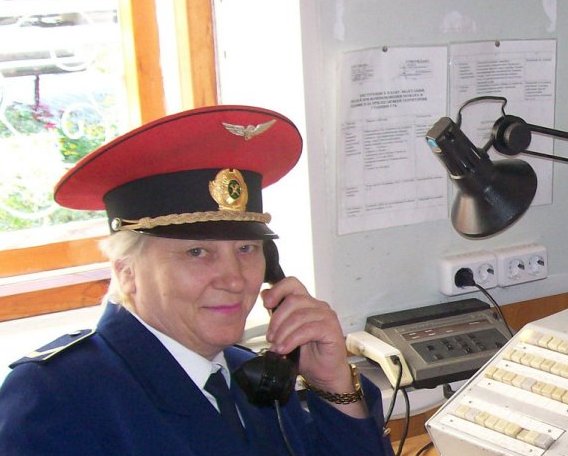 |
Railways
Signaler/Track Foreman
1955-1963
Similar in concept to the red-topped duty cap discussed above, yellow-topped caps were worn by personnel serving on duty as site signaler or track foreman. The yellow clearly identified that function to other personnel, including train engineers. The cap could even serve in lieu of signal flags, with guide-books published as to how that was to be done.
The signaler color combination of yellow and green was unique during the Soviet era. The crown is sewn from napped yellow wool while band and piping are in green wool. The semi-circular fiberboard visor, oilcloth chinstrap and silver colored buttons were standard to this period. The Railways cockade here is very heavily worn, with the original nickel only remaining in the crevices of the brass base metal.
Although this is the only signaler cap in my collection, please understand that such caps existed for every period from 1943 until the end of the USSR in 1991. The crowns were always yellow and
both band and piping were green. Only the size of the crown and the cockades/emblems worn on those caps changed according to the regulations in effect at the time.
Very Rare
Railways
Middle Staff Winter
1963-1973
Railways' uniforms were simplified in 1963, with previous multi-colored piping returned to standard green; the color it was to remain to the present day. Uniform color was officially changed to black - instead of the earlier prescribed dark blue. In actuality, this only impacted more senior Railways' officials, since junior personnel had been wearing a virtually identical blue/black hue for many years. Insignia also changed, altering the shape and size of the cockade and adding a winged wheel emblem to the crown.
This is a locally tailored cap, displaying the heavy plastic visor characteristic of one made in Ukraine (similar to those made for the Merchant Marine). The crown is a high-quality gabardine and the band is black velvet; both marking the owner as a more senior official. In fact, the combination of black velvet and the oilcloth chinstrap more specifically ranks him as middle staff. Lower grade personnel would have had plain black wool bands and more senior staff would have had filigree cords of silver (for senior staff) or gilt (for highest staff). The new cockade and emblem (the term normally used for the badge worn on the crown) are both stamped from aluminum. Two thin red stripes were painted on the stylized clasp holding the wreath. All personnel wore these same badges except for senior staff who wore embroidered versions (see box described below) and the highest staff (general-equivalent) who wore embroidered symbols in gilt wire. Buttons remained essentially unchanged from the previous period: still silver (nickel coated) and embossed with the crossed wrench and hammer symbol.
The light gray summer cap authorized to middle/senior/highest Railways' personnel by 1955 regulations remained in service, although with the new cockade/emblem.
You can see post-1973 versions of this cap later on this page. White cap covers were also still authorized
for middle and higher staff, but were now officially limited to those serving in the Caucasus, Central Asia and "the South" (not further identified).
Rare
Railways
Junior Staff/Rank and File winter
1973-1979
Although new uniform regulations were promulgated in 1973, these did not change uniform colors (although white covers/jackets were now abolished).
Both the crown and band of this 1979-dated cap were black wool; the plain (non-velvet) band marking the owner as junior staff (NCO-equivalent) or rank and file.
However, the crown is larger in height and circumference, reflecting changes to design specifications first laid down for military caps in 1969. Piping remained green on all caps. The visor is black lacquered fiberboard, the chinstrap is still black oilcloth with a plastic coating.
The 1973 regulations abolished silver ornaments, with all buttons and emblems now gilt. The M-1973 cockade was in the form of an oval with superimposed
crossed wrench and hammer on a green painted background surrounded by a six-leafed wreath. The crown emblem is also gilt and differs from the 1963 model
in the details of both the wings and the wheel.
Available
Railways
Station Duty Officer
1973-1979
This 1978-dated cap represents a later version of the red-topped station duty officer cap described above. The crown is larger but is still sewn from napped red wool with matching red
piping. The band is plain black wool. The visor is one of the first plastic ones manufactured - in the two-rim style commonly seen on Railways caps of the 1970s and 80s. The black chinstrap and gilt buttons are standard, as is the
gilt M-1973 cockade and winged-wheel emblem.
Rare
Railways
Highest Staff Summer
1973-1979
The gilt embroidery and buttons embossed with the Great Seal of the USSR mark this cap as belonging to a Railways' highest staff official - or general equivalent.
Dated 1978, this cap was part of the light gray summer uniform, with matching crown fabric, green piping and black velvet band. The visor is plastic, which was not used for general-equivalent caps made in Moscow,
but was often seen in Ukrainian-made caps as seen here - especially those intended for Railways. Gilt filigree cords are held in place by two-piece general-style buttons. Both the cockade wreath and the crown wings are gilt wire embroidered
onto light gray fabric matching that of the crown and then sewn onto the band and crown respectively. A separate Railways' cockade is pinned to the center of the gray-backed wreath. Note how the style of the M-1963 wings and wreath differ from
model 1979 insignia used on the cap below.
Rare
Railways
Engineer Winter
1979-1985
Caps made during this six-year period incorporated the color scheme and accessories mandated by the M-1973 regulations along with new M-1979 insignia more commonly associated with the 1985 regulations. Black remained the winter uniform color; light gray the summer color for middle/senior/highest staff.
With the exception of the white ribbon at the top of the band, this 1983-dated cap displays the standard elements authorized to middle grade (company-officer equivalent) staff. The crown is black diagonal wool, piping is green wool and the band is black velvet (as worn by middle/senior/highest staff). A black oilcloth chinstrap is held in place above the plastic visor by two gilt Railways' buttons. Both insignia are gilt anodized aluminum of a new design; the one-piece cast cockade being particularly thick in comparison to the more elegant M-1973 version. There may be stamped versions of this cockade, but I've never seen one.
The white ribbon around the band identifies this particular cap as belonging to an locomotive engineer (driver). The mark of this distinction evolved over the years: in 1943 it was to be a silver galloon (lace) ribbon 8-10mm wide but changed to a white silk ribbon in the same size
after 1955 (although surviving examples in Russian collections show some engineers still chose to wear silver lace at least into the 1970s). No particular pattern for the lace was established and engineers apparently used whatever was available.
Rare
Railways
Highest Staff Winter
1979-1985
While unmarked, this cap has the hallmarks of being tailor made in a port city along the Black Sea. General-officer equivalents of non-military ministries stationed in the Ukraine did not often have the opportunity to travel to Moscow to have their caps made at the Central Experimental Manufacturing Combine - the factory most often associated with Soviet general-officer caps. Consequently, they had to turn to local tailors administering to Merchant Marine officers, who had their own unique manufacturing style. This is aptly displayed on this cap, where the back of the crown flares out to a much more pronounced degree (apparently giving a more dashing appearance) and and in the heavy, multi-layered plastic visor so representative of caps worn by senior Merchant Marine and River Fleet officers.
Turning to the rest of the cap, the crown is black wool piped in green and the band is black velvet - as you would expect in a senior official's cap. The visor is as described, with gilt filigree cords supported by general-officer style buttons embossed with
the Great Seal of the USSR. The gilt wire embroidery on the band and crown are in the new M-1979 design.
Both this wreath and wings are sewn onto a black cloth backing matching the crown material. The gilt and green cockade pinned through the center of the wreath is also of a new design. These two insignias
are pinned onto the band and crown (vice sewn), in the manner of senior Navy and Merchant Marine officers.
Rare
Railways
Chief Conductor Summer
1979-1991
This 1986-marked cap would have been worn by a Railways' Chief Conductor. While the rest of the cap is standard for a middle/senior grade official of the period (described below); the twisted red cords set it apart from
any other used on the Soviet Railways. These red cords distinguished this position from at least 1955 on. Like the white lace on the engineer's cap above,
these cords were apparently not factory-made and would have had to be obtained from a local tailor. Consequently, it seems likely that no two such cords were exactly the same.
While I cannot confirm the authenticity of these particular cords, they are certainly made in the "Soviet" style with the unique sliding loops used to tighten them around the side buttons and accurately
illustrate this very rare Railways' cap variant.
Very Rare
Railways
Middle/Senior Staff Winter
1985-1991
1985 marked a major change in Railways' uniforms, with, among other things, dark blue replacing black as the color of the winter uniform. This was a true dark blue, not a return to the blue-black hues used before 1963.
This 1989-marked cap had all the elements of one authorized to middle and senior staff after 1985. The top is dark blue, piping is green and the band is black velvet.
Gilt cords were now authorized for middle grade officials and above (previously only highest staff wore those cords). These were secured using standard gilt metal Railways' buttons above the common two-rimmed plastic visor.
Both cockade and winged-wheel insignia remain unchanged from that introduced in 1979.
Common
Railways
Senior Staff Summer
1985-1991
Following entry into force of the 1985 uniform regulations, only senior and highest staff were authorized to wear the light gray summer uniform.
This cap further reflects this official's grade in that the band is black velvet and gilt cords are worn instead of the black chinstrap.
The visor and other accessories are the same as for the cap just discussed.
Available
Railways
Junior Staff/Rank and File
1985-1991
Under the 1985 regulations, caps belonging to NCO-equivalents and the rank and file were identical to those of middle/senior staff except in the substitution of plain black wool (instead of velvet) for the band and a black chinstrap in lieu of the gold cords of the more senior officials. This 1985-dated cap has the standard dark blue crown with green piping, black plastic visor, gilt buttons and gilt ornaments.
The brighter blue of this cap's crown compared to the middle/senior staff cap two sections up is not just due to lighting. They are actually two distinctly
different hues, demonstrating what every collector of Soviet caps must constantly keep in mind: the nature of a command economy such as the USSR's placed
more importance on meeting production quotas than in quality (and least outside the more regulated Ministry of Defense), was highly susceptible to delivery backlogs, and was reliant on a huge number of poorly regulated subcontractors
which often resulted in noticeable uniform fabric color and material variations.
Common
